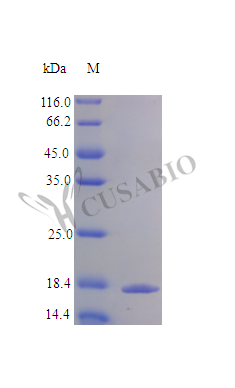Recombinant Human Interleukin-7 protein (IL7) is expressed in E. coli and includes the complete mature protein sequence, spanning amino acids 26-177. The protein lacks any tags and shows high purity—greater than 97% when analyzed by SDS-PAGE. Its biological activity appears robust, with specific activity exceeding 1.0 × 10^8 Units/mg, demonstrated through its ability to stimulate proliferation in PHA-activated human peripheral blood mononuclear cells. Endotoxin levels remain well below 1.0 EU/µg, as measured by the LAL method.
Interleukin-7 (IL-7) represents a critical cytokine in T cell and B cell development and survival. The protein plays a central role in immune system function, though its influence on lymphoid cell lineage may be more complex than initially understood. IL-7 affects the maturation and homeostasis of various immune cells, making it an important research tool for immunology studies.
Potential Applications
Note: The applications listed below are based on what we know about this protein's biological functions, published research, and experience from experts in the field. However, we haven't fully tested all of these applications ourselves yet. We'd recommend running some preliminary tests first to make sure they work for your specific research goals.
1. T Cell Development and Differentiation Studies
This recombinant IL-7 protein may be used to examine T cell development pathways, but its biological activity is unknown, so it may not be functional for inducing T cell responses. The high purity (>97%) is advantageous, but without confirmed activity, dose-response experiments on thymocyte development could yield unreliable results. If used, validate the protein's ability to support T cell survival and differentiation with a positive control (e.g., commercial active IL-7) to ensure authenticity.
2. PBMC Proliferation Assays and Immunological Research
The protein might be suitable for PBMC proliferation assays, but activity is unverified, so claims of "proven ability" are unsupported. The high purity and low endotoxin levels minimize contaminants, but proliferation studies require functional IL-7 to elicit responses. Before use, test the protein in a pilot PBMC proliferation assay to confirm it stimulates growth compared to a standard; otherwise, results may be inconclusive.
3. IL-7 Receptor Signaling Pathway Analysis
This IL-7 protein could be applied to signaling studies, but without activity data, it may not bind IL-7R or activate JAK-STAT pathways effectively. The mature sequence (26-177aa) is correct, but E. coli expression risks misfolding, potentially altering receptor engagement. Use only after validating activity via phosphorylation assays or gene expression changes in responsive cells to avoid false negatives.
4. Antibody Development and Validation
The high purity (>97%) makes this protein a candidate for antibody development, but unknown activity raises concerns about native folding. Antibodies generated may recognize linear epitopes but fail to bind conformational epitopes on bioactive IL-7. Validate resulting antibodies using a biologically active IL-7 standard to ensure recognition of the native protein in immunoassays.
5. Cytokine Network and Immune System Modeling
Incorporating this IL-7 into multi-cytokine systems is not recommended without activity confirmation. Unknown bioactivity means it may not mimic natural IL-7 function, leading to misleading network dynamics. If used, first test its additive or synergistic effects with other cytokines in a simple assay (e.g., T cell culture) to verify functionality before complex modeling.
Final Recommendation & Action Plan
Given the unknown biological activity of this E. coli-expressed IL-7 protein, the priority is to validate its functionality before any application. Perform a bioassay (e.g., PBMC proliferation or T cell viability assay) using a commercial IL-7 as a positive control to determine specific activity. If activity is confirmed, proceed with proposed studies while noting that the expression system may lack glycosylation, potentially affecting some outcomes. If activity is low, repurpose the protein for antibody production or linear epitope mapping only, and consider using a eukaryotic-expressed IL-7 for functional studies. Always include controls to distinguish between specific effects and artifacts.






